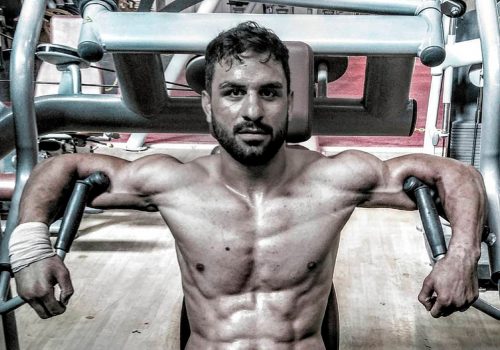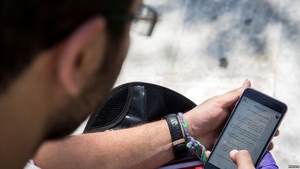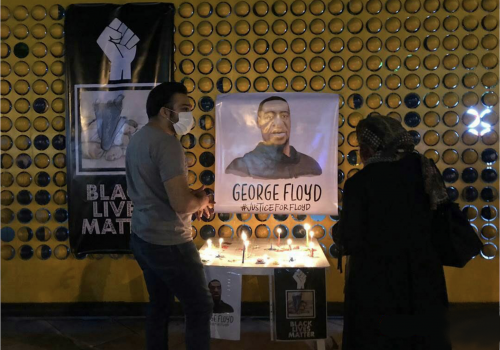#No2IslamicRepublic: Just a hashtag or much more?
On March 20, Iranians celebrated Nowruz, the beginning of the new year. Many had long hoped for this year’s Nowruz to be special, as it heralded the solar year 1400. But as Iran enters the fifteenth century, the country is seeing some of its most challenging times in modern history. It’s no surprise that, on March 11, an anti-government campaign was launched with the hashtag #No2IslamicRepublic in English and Persian (نه_به_جمهورى_اسلامی#). The movement was announced via a statement signed by 640 Iranians, including those inside and outside Iran.
The statement calls on “fellow Iranians who wish for Iran’s freedom and prosperity” to unite around the slogan, “No to Islamic Republic”—which has been chanted by many protesters—as a “central point of national solidarity for a vast and broad movement” against the ruling regime. It calls for a struggle towards “freedom, prosperity, democracy, progress, and human rights.”
The signatories include many activists living Iran. One of the best-known is filmmaker Mohammad Nourizad, who once made films supporting the Islamic Republic but has now spent years in and out of prison due to his acerbic criticisms of the Supreme Leader Ayatollah Ali Khamenei. He is joined by women’s rights activist Shahla Entesari, teacher unionist Javad Lal Mohammadi, and pro-democracy activists Abbas Vahedian and Zartosht Ahmadi Ragheb. These five all previously signed the Statement of Fourteen, an open letter in 2019 that had called for Khamenei’s resignation and landed them in jail.
The viral #No2IslamicRepublic campaign is also supported by many Iranians abroad, including singers who are household names in Iran—Gogoosh, Ebi, Dariush, Shahin Najafi—legendary composer Esfandiar Monfaredzade, award-winning filmmaker Bahman Ghobadi, historian Touraj Atabaki, feminist sociologist Haide Moghisi, former Ontario cabinet minister Reza Moridi, and women’s rights activists Fariba Davoudi Mohajer and Fathiye Yazdi.
However, the most public face of the campaign is Reza Pahlavi, Iran’s last heir to the throne before the overthrow of the monarchy during the 1979 revolution. The sixty-year-old Pahlavi is perhaps the best-known figure of the abroad-based opposition, but he has struggled to bring together its discordant ranks. To bridge differences, he is now emphasizing a ‘big tent’ approach. More importantly, Pahlavi recently made a major position shift by declaring his preference for a republic over a return to the constitutional monarchy championed by many of his supporters. In a video message on March 15, Pahlavi emphasized that “no political party, group, or current” could claim exclusive ownership of the campaign since it had “come from within Iranian society.”
From dissent to change
There are plenty of grounds for dissent in Iran.
The economy suffers from corruption, mismanagement, and punitive US sanctions, which have helped eviscerate the middle class. Not only can many families not afford the traditional Nowruz dish of sabzi polo mahi (herbed rice and fish), some now make do by buying chicken skin or bones instead of any meat. Just days before the Iranian new year, a commentator on state television asked people to “reduce their expectations” by not eating fruits, meat, and chicken and to “eat rice on its own.” Amidst a collapsing economy, increasing repression by the government—including killing at least three hundred protesters in 2019—and a deadlock in talks with the United States, the Islamic Republic finds itself despised by many Iranians.
President Hassan Rouhani was elected in 2013 and re-elected in 2017 on two major promises: He would make Iran freer and that the country would become more prosperous via a nuclear agreement with world powers that would provide sanctions relief. He has failed miserably on both counts—the latter albeit partly due to the Donald Trump administration’s withdrawal from the accord and reimposition of sanctions. Rouhani launched an Iranian Bill of Rights in 2016 but has struggled to contain the repression committed by forces loyal to the Supreme Leader—who holds most of the power, as stipulated by the constitution—such as the judiciary and the Islamic Revolutionary Guards Corps (IRGC). Even Rouhani’s ministries have proved repressive, as evidenced by the unprecedented shutting down of the internet by his information and communications technology minister and the recent banning of a popular charity organization following a request by his interior ministry.
Rouhani’s successor will be elected in the presidential elections on June 18. As with all elections in Iran, candidates must be approved by the Guardian Council, a body whose members are appointed, directly or indirectly, by Khamenei. During the February 2020 parliamentary elections, the council banned the candidacy of dozens of sitting pro-Rouhani MPs and ensured a solid conservative majority outcome. It’s unclear who will get the green light to run in June to carry Rouhani’s torch. Under Khamenei’s direction, the council usually allows at least one reformist or centrist candidate to run in the presidential elections to broaden the basis of their legitimacy, although it has also disqualified former presidents Mahmoud Ahmadinejad and the late Ali Akbar Hashemi Rafsanjani.
Many believe this will be the first election since reformist Mohammad Khatami’s surprise win in 1997 not to see much turnout. Armane Melli, a daily close to the Rafsanjani family, spoke for many when it warned about “economic discontent and people’s indifference to the elections which might seriously decrease the turnout.” Human rights activist Narges Mohammadi, who endorsed Rouhani in 2017, is among many who have already declared a boycott.
Is change coming?
But can this widespread dissent help the popular hashtag campaign get anywhere?
Iranians are no stranger to anti-government movements. In the past few years alone, hundreds were killed by authorities in the nationwide protests of December 2017-January 2018 and November 2019-July 2020. Most Iranians still remember the 2009 Green Movement, following a disputed presidential election, and the 1999 student-led protests. Since the campaign began, support for it has emerged inside Iran, not just on social media but also via videos sent to Persian language diaspora satellite channels.
Manoucher Bakhtiari, whose twenty-eight-year-old son, Pooya, was killed in the 2019 protests, published a video to show his support. The sister of Kamal Faraji, a forty-one-old-year carpenter also killed in the 2019 protests, visited her brother’s grave ahead of Nowruz and posted a video wishing “overthrow of the Islamic Republic regime” in the coming year. Perhaps more striking were several anonymous videos, clearly taken in Iran based off their locations, using the slogan, “No to the Islamic Republic,” written on a piece of paper or simply the palm of their hands. In one, a Twitter user showed his uniform to reveal he was an officer in Iran’s national police.
But channeling this dissent into an organized movement against the Islamic Republic is no easy task. The Iranian regime has ferociously repressed and harassed its critics at home and has even assassinated, kidnapped, and murdered its opponents abroad in some instances. Furthermore, the ranks of the opposition are infamously divided. Many fret working with Pahlavi. who has never renounced his father’s repressive regime. Others accuse those who’ve supported the reformist or centrists in Iranian elections as being collaborateurs. The uphill task for the #No2IslamicRepublic proponents is building a united opposition front that can offer a credible alternative to the brutal Islamic Republic.
Arash Azizi is a writer and scholar based at New York University. He is the author of, “The Shadow Commander: Soleimani, the US and Iran’s Global Ambitions” published by Oneworld Publications. Follow him on Twitter: @arash_tehran.
Image: People stop their cars in a highway to show their protest against increased gas price in Tehran, Iran November 16, 2019. Nazanin Tabatabaee/WANA (West Asia News Agency) via REUTERS


